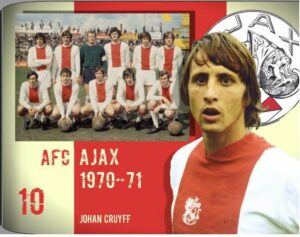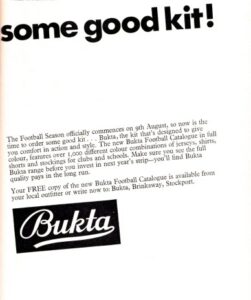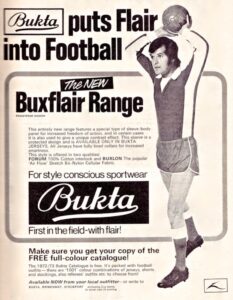You can’t judge a book by it’s cover but the cover is the first thing you see. Ajax have always had classic kits.
Who could forget the legacy 1989-90 Umbro away kit. Dennis Berkamp at the start of his career. De Boer brothers killing it in the league. The uniform has colours of red, blue and white. It follows a geometric pattern that cuts the front, back and sleeves. The main sponsor TDK, was boxed in a red text on a white block background.
Don’t forget the Adidas away – 2004/05 kit. Van der Vaart and co ran around in stripy, pale yellow kit. Yellow socks. Three gold stripes when playing from home. ABN-AMBRO sponsors in black writing on the last string in vertical reading.
Then there’s the recent Adidas third kit from the 21/22 season. Bob Martey is a music icon and the club paid tribute when Adidas announced a partnership for a tribute kit with solid black colouring with stripes running down the shoulders and sleeves in the colours of the Jamaican flag. Bob Marley produced and recorded ‘Three Little Birds’ which went on to become the unofficial anthem of the club. His son, Ky-Mani Marley also went on to sing the song in legacy. To this day, it still remains one of the best selling shirts of 2021.
There are so many iconic kits. But what started it all?

According to footballarchive.com, Ajax Amsterdam’s team kit can be traced back to 1900. Until 1970, Ajax allegedly only made their kit in-house in the Netherlands.
It wasn’t until the 1970-71 season, they outsourced to a British company.
The 1970-71 season
Worn by people like Barry Hulshoff, Dick van Dijk, Gerrie Mühren, Wim Suurbier, Johan Neeskens, Ruud Krol, and Ruud Krol, the ushering in of the new team kit took place during an iconic season.
The squad that season had juggernauts such as Johan Cruyff and Dick van Dijk.
Even though the finished 2nd to rivals, Feyenoord, which is a bitter pill to swallow even it’s buried so long ago, they also managed to be crowned European champions as well as winning the KNVB Becker cup.
In fact, the European final was held in Wembley with 83,179 in attendance. Ajax were facing Panathinainakos of Greece. Ajax were appearing in their 2nd final after losing to A.C.Milan in the 1969 final while their Greek opponents were in their first.
Van Dijk opened the scorebooks with a 5th minute screamer before Haan scored the second in the 87th minute to secure the trophy. During the tournament itself, Ajax won all their ties comfortably by two goals.
The Becker cup final took place at De Kuip, Feyenoord and was attended by 63,000 fans. Ajax faced RV and AV Sparta who went toe to toe.
Both teams fought hard and finished with a scoreline of 2-2 including extra time with no penalties on the 5th May.
The federation decided on a decider match to take place again on 20th May, which Ajax went onto win 2-1. This included a masterclass from Cruyff who engineered two assists as well as a long range bullet from Johan Neeskens.
Instrumental in registering trophies was manager, Rinus Michels.
In 1999, he was voted as the FIFA coach of the century and regarded as one of the greatest of all time.
![]()
Bukta
Bukta is an English sportswear company that was established in Stockport, Cheshire, England, in 1879. It was also a well-known manufacturer of tents and outdoor gear throughout a significant portion of the 20th century.
Less than 30 people were employed by Bukta when it relocated in 1885 to a new plant at Woodside in Poynton, Chesire.
In addition to producing knickers, hospital and tropical uniforms for the British Army during the First World War, it was one of the first companies to create uniforms for the Girl Guides and Scout Movement.
Bucks purchased the business in the infamous Vernon Estate Sale in 1920. E.R. Buck and Sons had between 130 and 200 employees when it was incorporated as a limited business in 1923.
After a hiatus of more than six years, the Bukta brand was resurrected in 2005 as an upscale independent retail brand, with millions of pounds invested in it. The Cavden Group. It is contracted to handle a large portion of Bukta’s distribution and design.


The first ever team Bukta worked with was Arsenal on their home kit in the 1930-31 season. Aston Villa joined their portfolio in the 1956-57 season before moving onto the international scene with Northern Ireland in the 1958 season.
Bukta soon started producing kit for over thirty teams in England and Europe.
They were a marginal mainstay in mainland Europe but lacked the financial clout to stop the giant companies such as Adidas, Reebok and Nike.
The kit
The shirt itself is very minimalistic. No logos. No sponsors. No writing. Just the stripes themselves and the colours of Ajax Amsterdam. Two white stripes with a red stripe down the middle. All of this as the defining pattern for the entirety of the shirt.
The small crest of Ajax, which you can barely see, nestled on the left chest position.
Kit numbers on the back outrageously bigger than the average numbers on shirts you see in today’s game.
Bukta now
After a quick google search, the activity of it’s brand seems to be relatively low, with no official communication correspondence or store base.
As a massive import and export firm, The Cavden Group has a large presence on the outskirts of Manchester. Their distribution and designs are primarily outsourced to independent up-market stores now.
After an absence of six years, Bukta brand was relaunched in 2005 having had millions of pounds spent on it.